Featured Stories
Sundown for Bob Stane’s Coffee Gallery Backstage: 1998-2023
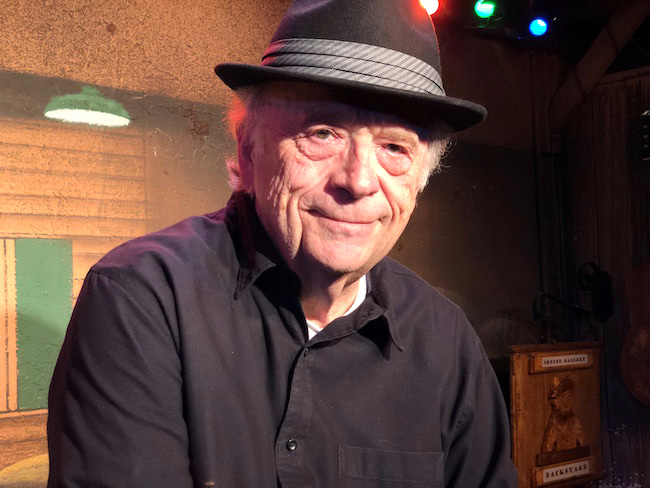
Bob Stane, owner of the long running Coffee Gallery in Altadena.
Twenty-five years since its opening, Bob Stane, one of the founding Godfathers of the American Folk Music Movement, has decided to close his signature venue, Tthe Coffee Gallery Backstage in Altadena, California.
The decision was not easy nor as sudden as it may have seemed. His recent health crisis had slowly crept up on him since last January when he began to make public his desire to retire and close the venue. At 86 years old, Bob is long past retirement age. In fact, opening the Coffee Gallery Backstage in 1998 could be considered a retirement gig for the long-time music pioneer and entrepreneur. He just couldn’t keep still without contact with live music. In a way, his years with the Coffee Gallery Backstage have been his personal restless farewell with apologies to Bob Dylan.
Always an original, Bob Stane chose to rewrite his own rules of retiring in his 60s in 1998 as he re-wired his career by establishing the charming, slightly out-of-the-way venue. It was neatly hidden in the foothill community of Altadena, a few miles north of Pasadena. It has been situated in the back of a coffeehouse, a funkier and far more soulful version of Starbucks that attracted not only coffee drinkers but a constantly engaging community of loners, weary-eyed misfits, college students, crafty quilters, talented painters, and a variety of young and old bohemians, and armchair philosophers. Eventually, local buskers and self-styled folksingers began to show up and formed a front-door stage for open mic nights.
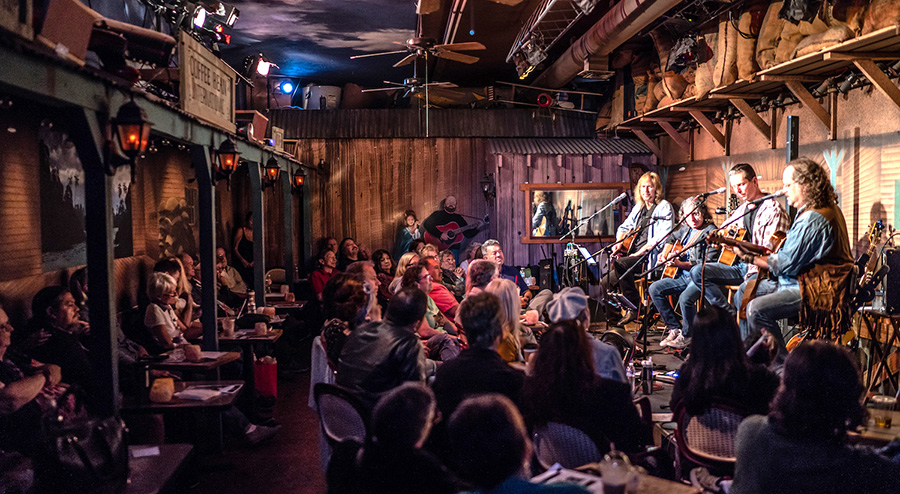
The warm and cozy interior of the Coffee Gallery.
The Backstage performance venue was a place only Bob Stane could have designed. It was modeled after a Costa Rican coffee plantation with a self-portrait of the artist and his daughter painted into the east wall to greet audience members as they strolled to their chairs. There was always a good seat among the 49 chairs for the intimate audience of music fans.
Not to be outdone by logistics, Bob consolidated the box office ticketing and technical controls at the entry with a large wooden door with a chair on either side. Bob would occupy both during operating hours at various times like a one-man train conductor/engineer would change hats depending on required duties. To be sure, Bob has had supporters who helped keep the place relevant and energized. But, at the end of the day, Coffee Gallery Backstage has found Bob in his own zone—a temple to the spirit of creativity, talent, and music he has always attracted.
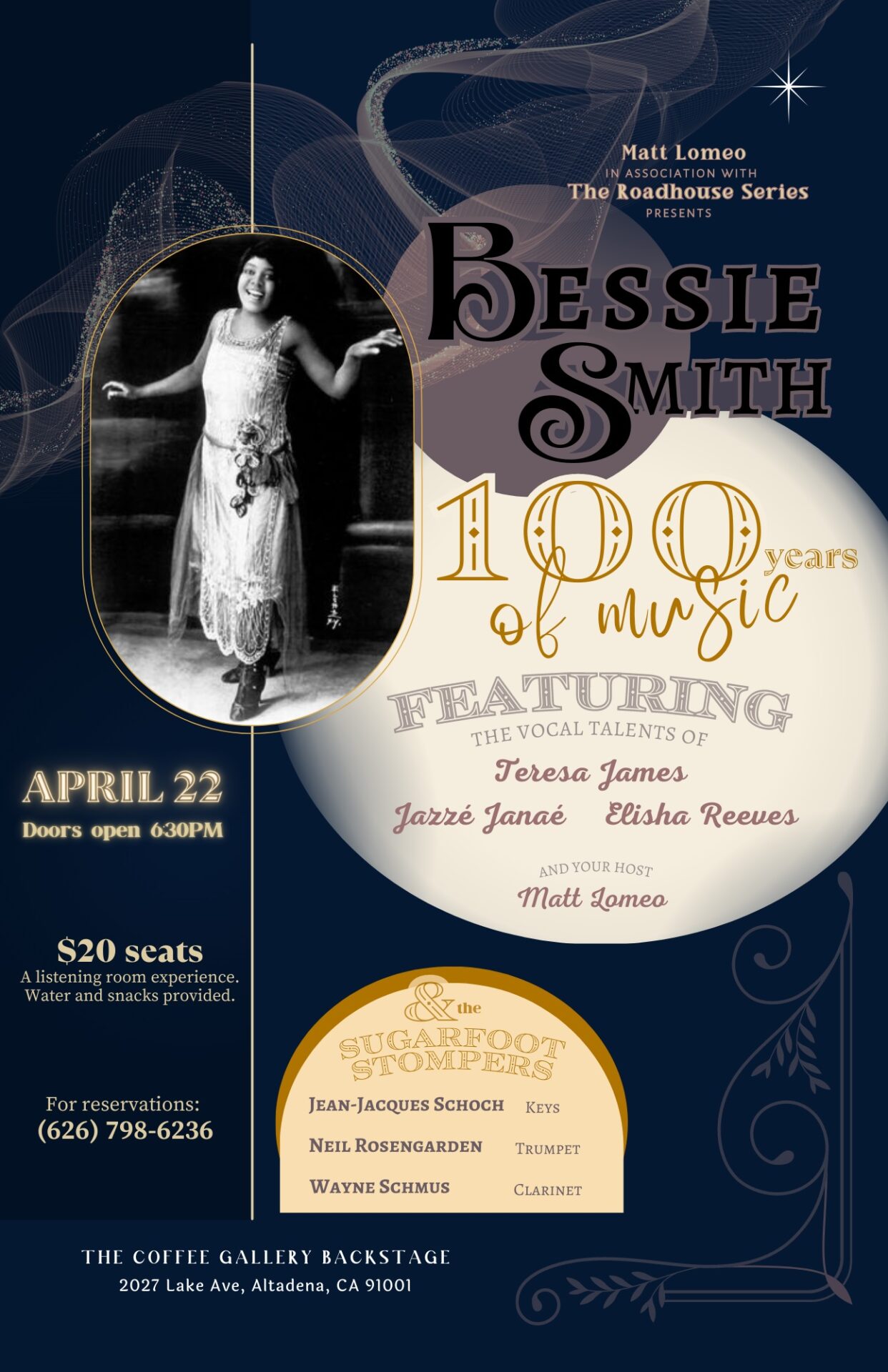
Poster for a recent show at the Coffee Gallery.
For admission, everything was done as cash-on-the-barrel, and the call-in reservation system used no credit cards. Sound, lights, and announcements were done by Bob on the theater side of the door from his “Captain’s Chair,” a worn and tattered black vinyl office chair on wheels. He always had his announcement microphone ready, and he began the shows with the “seductive dimming of the lights” and accompanying “oohs” and “ahhs” from the audience.
Bob was the lead sound-wave surfer, the Big Kahuna of Folk Music, and the Venerable Captain Trips with an eclectic roster of the finest in American music. From this place, he conducted his business as usual, including booking the best musical acts. He would instruct, nurture, support, and grow performers with wisdom, humor, and insight. His suggestions on stagecraft, if taken seriously by the artists, helped them to form a stronger connection with the audience. Over the years, the artists who came to play at the venue read like a unique Hall of Music-Fame of excellent roots music. They include Chris Hillman, P.F. Sloan, Herb Pedersen, Randy Sparks, Terry Talbot, Barry McGuire, Chad Watson, Pam Loe, Butch Hancock, Karen Tobin, Carolyn Hester, Matt Cartsonis, John York, Wendy Waldman, John Stewart, Buffy Ford Stewart, Louise Goffin, John Bleland, Carla Olson, Bill Mumy, Paul Zollo, Jeremy Clyde, Duane Thorin, Rumur, The Good Intentions, Harriett Schoch, Chris Darrow, Peter Tork, Coco Dolenz, Chris Gantry, Len Chandler, Peter Lewis, The We Five’s Jerry and Debbie Burgan, Tholow Chan, Paul Marshall, Darrell Mansfield, Neil Rosengarden, Louise Goffin, Dave Stamey, Ledward Kaapana, Fanny, JayDee Maness, Marty Rifkin, Dean Parks, Chelsea Williams, Jim “Kimo” West, Jennifer Warnes, Roland White, John McEuen, James Lee Stanley, and so many more.
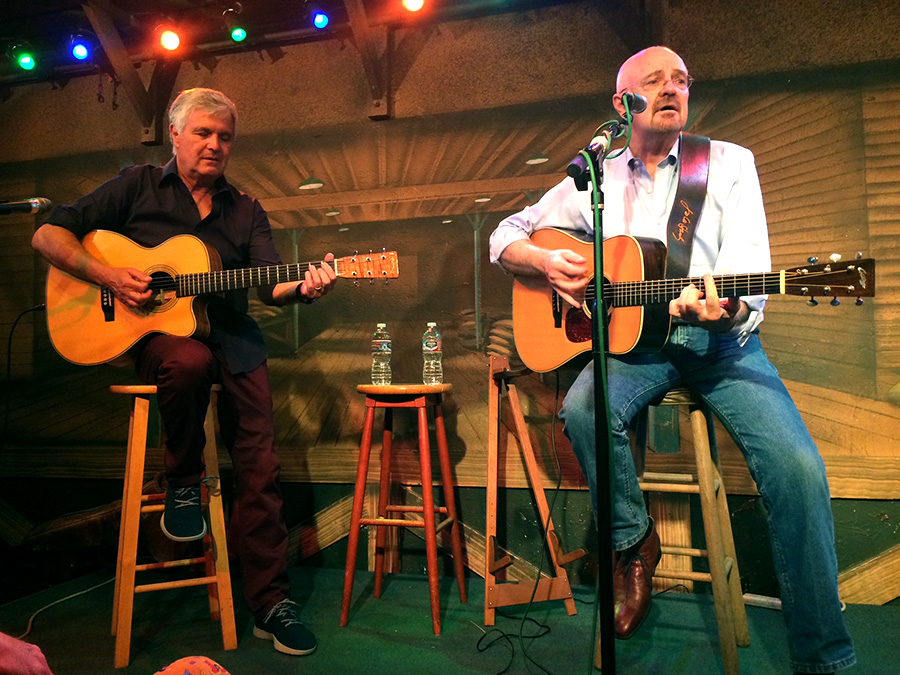
Troubadour friends Lawrence Juber & James Lee Stanley perform at the Coffee Gallery a few years back. Photo by Liz Abbott.
Since then, tributes have been posted all over social media. But these comments from singer-songwriter Harriet Schoch, who wrote “No Way to Treat a Lady,” sum up many of the feelings of others.
I want Bob Stane to get my message so I’m posting it here. The FB page for the Coffee Gallery Backstage posted that Bob would recover. For this I am immeasurably grateful. It’s not an overstatement to say that Bob Stane is responsible for my 50-year career in the music business. When he had the Ice House, I performed there and got my major label record deals. That led to everything else—the covers, seven more albums, film, and TV work—everything. I also made my live album at the Coffee Gallery Backstage. Without his guidance and support, today I might be asking if you want fries with that. I—and the rest of the business not only here in L.A. but also worldwide—owe Bob Stane a tremendous thank you. Bob, you’ve helped a whole generation of singer-songwriters. We all love you more than you can imagine.
The last weekend of shows held at the Coffee Gallery Backstage was like a microcosm of the venue’s historic musical past. Beginning with a sold-out show on Friday night, April 21, the Storytellers, a local progressive bluegrass string band. The young musicians have been regulars at the venue as Bob Stane has served as a mentor and an inspiration to the up-and-coming band. It’s the teacher-student role that Bob began with artists like John McEuen, David Lindley, and Tom Waits in the early 1960s. According to Storytellers bassist Lance Frantzich:
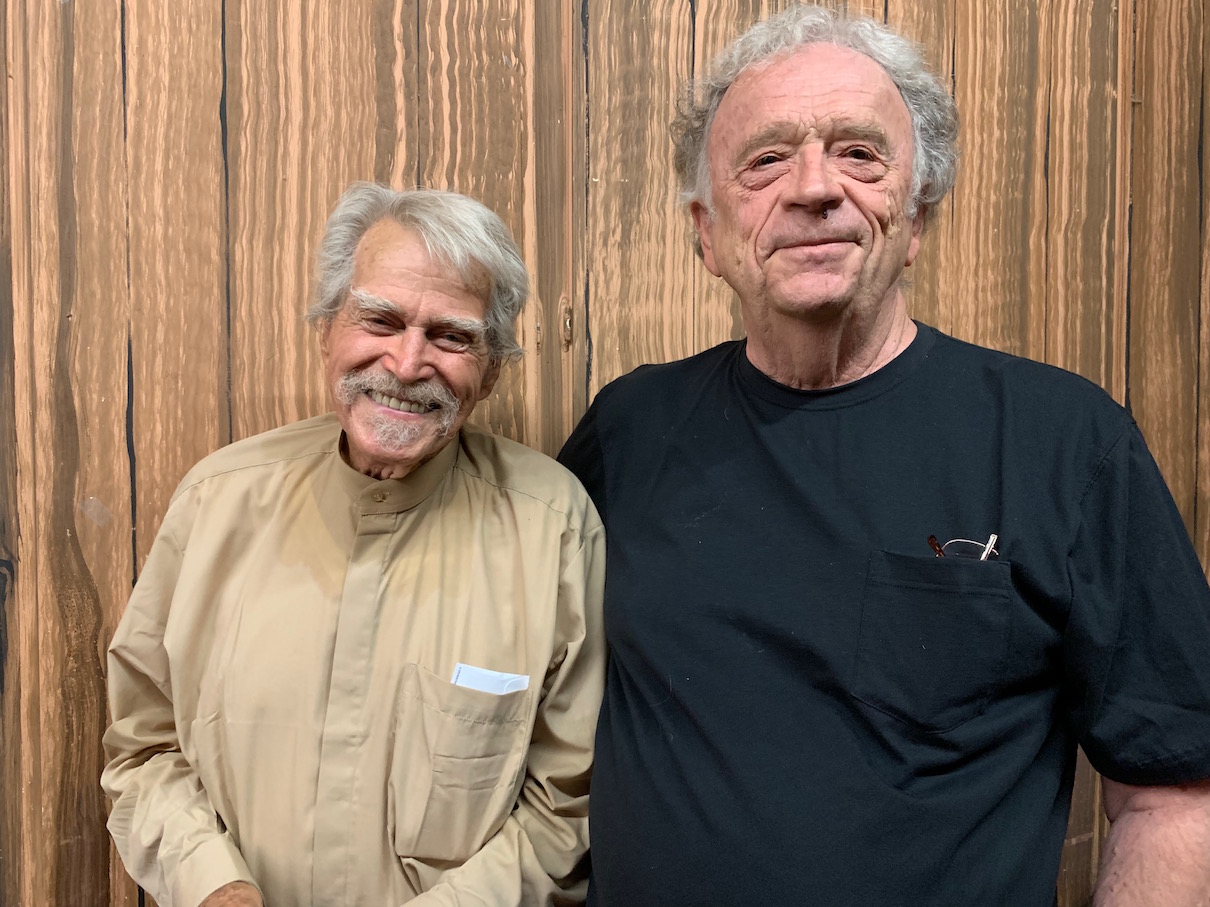
Bob Stane and his old pal Randy Sparks of the New Christy Minstrels.
Our Coffee Gallery shows were essentially master classes with Bob Stane. The show would end, and our education began with loving and honest feedback after the show, sometimes a week later over lunch. When we arrived on that last Friday to load in with no Bob in sight, we all felt sick. We knew it wasn’t good. We always understood that Bob was indispensable to any show, but it took him not being there to fully grasp the depth of it. Maybe we graduated from those classes. After our two sold-out shows in February, he said, “You’ve learned your lessons.” He wanted to make a video certifying to the world that we are ready. That pleased us, but we never did publish the video. We didn’t want it to end. We were Bob’s last mentoring project. Now it’s up to us to listen to his voice in all that we do, urging us to attend deftly to the fine details of the music and performance. That was Bob’s way. All that’s left now is to take what we learned out into the world.
On April 22, veteran singer-songwriter John York returned for a matinee of his moving solo acoustic show opening with the Carole King/Gerry Coffin classic “Going Back,” a song that was once covered by York’s old band, The Byrds. But knowing this would be his final show made the song resonate deeply as he sang:
Now there are no games
To only pass the time
No more electric trains
No more trees to climb
But thinking young and growing older is no sin
And I can’t play the game of life to win.
The Roadhouse Series concluded its run at the venue with singer-songwriter and blues harmonica player, Matt Lomeo, hosting. The show paid tribute to the great blues artist Bessie Smith. Lomeo assembled a band representing the kind of musicians Smith sang with during the Roaring ’20s of the 20th Century, including piano, trumpet, and clarinet, which included Jean Jacques Schoch, Neil Rosengarden, and Wayne Schumus, respectively. The singers, including Teresa James, Jazze Janae, and Elisha Reeves, sang passionately and were elegantly dressed in honor of the songs of the great blues vocalist.
Over its six-year run at the Coffee Gallery Backstage, the Roadhouse Series, conceived by Bob Stane, singer-songwriter Patrick Carrico, and yours truly, Terry Paul Roland, brought together local and nationally known musicians to honor great American music and its artists. Among many of the magic moments during those years, none held more of the rock ‘n’ roll/Roadhouse mojo than the February 7th, 2017, Buddy Holly Tribute. Folk singer and living legend Carolyn Hester told us stories of how Buddy Holly played guitar on her songs at Norman Petty’s Clovis, New Mexico, recording studio. On this night, she sang a beautiful rendition of Holly’s “Lonesome Tears.” Most recently, tributes were paid to Bonnie Raitt and Ronnie Mack’s Barn Dance, which included Ronnie’s participation, joined by James Intveld, Carla Olson, Rick Shea, and Sam Nelson.
On April 23rd, the last day and last shows at the Coffee Gallery Backstage were “An Afternoon with Louis Kemp and the Music of Bob Dylan.” Louis Kemp, who recently published a book titled Dylan and Me, was interviewed by singer-songwriter, author, and music journalist Paul Zollo. Louis is Bob Dylan’s oldest and closest friend. His stories brought insight and gave an intimate look at what it’s like to be friends with this iconic artist. The first set included artists John York, Paul Zollo, Rick Bagby, Henry Zhao, Lorin Hart, and Matt Cartsonis. York and one of his final songs brought together this last day of music in this musically holy space with a moving interpretation of Dylan’s “A Restless Farwell.”
Oh, all the money that in my whole life I did spend.
Be it mine right or wrongfully.
I let it slip gladly to my friends.
To tie up the time most forcefully
But the bottles are done, we’ve killed each one.
And the table’s full and overflowed.
And the corner sign says it’s closing time.
So I’ll bid farewell and be down the road.
—Bob Dylan from “Restless Farewell”
But, bittersweet as this weekend was, it ended on a celebrative note with Coffee Gallery Backstage veteran and old friend of Bob Stane’s, Dave Morrison, who hosted an evening show with his band that included plenty of live music, food, and drink for an appreciative audience of fans and friends. I spent some time with singer-songwriters Severin Browne and Randy Miller, who were there to enjoy the venue’s concluding hours and a genuine folk tradition of Bob Stane’s legacy; a song circle was held to encourage and provide an outlet for young and old independent singer-songwriters.
By the time of closing, all those who attended and participated in the shows were relieved to know Bob Stane was well on the road to recovery. There was a sense of relief for everyone, knowing that the man would remain with us.
With this final weekend, a legacy of music and the result of a true restless creative vision came to a natural end. But maybe not. The closing of the Coffee Gallery Backstage is not so much an end as it is the beginning of an opportunity for so many artists in the acoustic-music community to grow their new visions (re-visions, if you will) and keep the road of musical adventures and innovations moving, always remembering the love and lessons they’ve received from the great Bob Stane.
For those of you who haven’t heard of Bob Stane, he has a long history of managing coffeehouses, with strong local ties in San Diego. The Upper Cellar on the SDSU Campus goes way back to 1958, when Bob started that venture. He even wrote a little handbook for those considering opening up a coffeehouse. After that had run its course, Bob went on to start the Ice House in Pasadena. Like Carey Driscoll of AMSD Concerts, he hosted dozens and dozens of top-drawer acts. Read the Troubadour article by Terry Roland from November 2016 to learn more about his San Diego roots. https://sandiegotroubadour.com/bob-stane-remembers-the-upper-cellar-and-the-coffeehouse-era/
An interview with Bob Stane.






